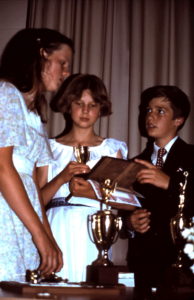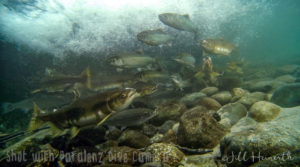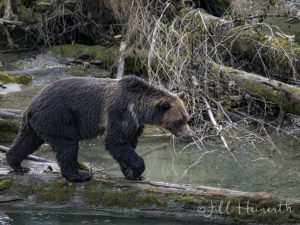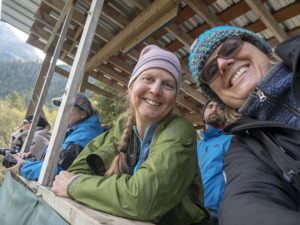
Dr. Jaqueline Windh and Jill Heinerth in Tofino in 2000.
My oldest friend Dr. Jaqueline Windh and I stumble through the forest that is damp with yellow fall foliage and arrive on the cobbled bank of the Quinsam River. We’ve known each other for 50 years and still love the same things we did as kids: getting dirty and observing the natural beauty of our extraordinary world. This reunion is an opportunity to celebrate our friendship and observe the remarkable cycle of life of the various salmon species that make British Columbia their home. Beneath the glassy surface of the fast moving water, eighty or more salmon turn their heads into the steady flow coming off a small weir with a singular focus to fulfill their role to spawn.

Jill and Jackie receive awards at Camilla Public School.
Their life begins here around a female’s nest of eggs called a “redd.” Beneath the insulating gravel bottom, fertilized eggs are already developing, to hatch as “alevins.” Next spring the minuscule alevins will carry their yolk sac on their bellies while they stay close to the redd. When they fully emerge from the gravel as fry, they will fill up their swim bladders with oxygen and begin to feed. For up to a year, they swim in their birth-spring while some species like the pink and chum will head to the ocean as smolts. Sockeye migrates to local lakes for a couple of years, while Chinook and Coho will hide under logs, escaping predators in the shadowy habitat that also prevents them from being flushed away in the strong current.
As smolt, the silvery fish receive some magical environmental cue that tells them it is time to head to the sea. Some small fish allow themselves to be swept downstream tail-first in the rushing water while large fish actively move to the ocean. In the estuaries, they transition to their new environment, feeding and gaining strength and size.
 Salmon spend from 18 months to eight years in the ocean. Some species stay close to their natal home while others head north to bountiful feeding grounds. Eventually, they know it is time to obey chemical cues that tell them to head back to their native stream to begin the process of spawning. Drawing on energy reserves and fat storage, guided by sunlight and scents, they instinctively migrate back to their birthplace, where they stop feeding all together.
Salmon spend from 18 months to eight years in the ocean. Some species stay close to their natal home while others head north to bountiful feeding grounds. Eventually, they know it is time to obey chemical cues that tell them to head back to their native stream to begin the process of spawning. Drawing on energy reserves and fat storage, guided by sunlight and scents, they instinctively migrate back to their birthplace, where they stop feeding all together.
As they create life, they also begin to die. All remaining energy is focused on the health of the reproductive organs. Finally reaching their original stream bed, females turn on their side and dig a small depression in the pebbled bottom while males with hooked noses fight for spawning rights. When the dominant male has made a connection with a female, they will release eggs and milt together. She covers her eggs and continues upstream to build another redd.
 The dying fish are easy targets for birds of prey and bears. They become zombies for the cause of reproduction and lose energy needed to escape capture. Those that are not killed and eaten directly become part of the nutrient stream that feeds the river’s next generation.
The dying fish are easy targets for birds of prey and bears. They become zombies for the cause of reproduction and lose energy needed to escape capture. Those that are not killed and eaten directly become part of the nutrient stream that feeds the river’s next generation.
At the Quinsam River, a hatchery further supports the salmon life cycle. They grow and supply up to eight million pink salmon eggs to the east coast of Vancouver Island and are also involved in salmon tagging research, adult recovery and biological sampling to support DFO and its Pacific Salmon Treaty obligations. Visitors can get a guided tour of the hatchery, but if you want a better opportunity for viewing, jump in the water with a mask and snorkel to see the action up close. You will find pink adults in September and Chinook and Coho adults in the river from October through November.

Jackie and Jill photograph grizzly bears on the Homalco Traditional Territory in Bute Inlet.
Jumping in the cold, running water, Jackie and I lay down and point ourselves into the flow like the salmon. Within a few minutes, large adults move back around us, occasionally brushing our sides or hiding beneath our bellies. We point upstream, answering an instinctual call that lures us back to the childhood joy of playing in the water. I feel like I am six years old again, a giant grin on my face and enjoying a moment with my best friend.
